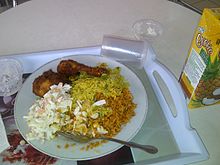Jollof rice /ˈdʒɒləf/, also called Benachin(Wolof: "one pot"), is a one-pot rice dish popular in many West African countries, eaten whenever desired. It is a West African version of pilaf or paella and possibly a progenitor of the Louisianian dish jambalaya.
Geographical range and origin
Jollof rice is one of the most common dishes in Western Africa, consumed throughout the region including Senegal, Gambia, Nigeria, Sierra Leone, Liberia, Togo, Cameroon, Mali and Ghana. There are several regional variations in name and ingredients, with non-local versions regarded as "inauthentic". The name Jollof rice derives from Wolof people of Senegal and Gambia, where it is considered a "national dish", though now called theibou dienn or benachin. In French-speaking areas, it is called riz au gras. Despite the variations, the dish is "mutually intelligible" across the region, and has spread along with the diaspora to become the best known African dish outside the continent.
Geographical range and origin
Jollof rice is one of the most common dishes in Western Africa, consumed throughout the region including Senegal, Gambia, Nigeria, Sierra Leone, Liberia, Togo, Cameroon, Mali and Ghana. There are several regional variations in name and ingredients, with non-local versions regarded as "inauthentic". The name Jollof rice derives from Wolof people of Senegal and Gambia, where it is considered a "national dish", though now called theibou dienn or benachin. In French-speaking areas, it is called riz au gras. Despite the variations, the dish is "mutually intelligible" across the region, and has spread along with the diaspora to become the best known African dish outside the continent.
The points of origin of the dish are hotly debated. Based on its name its origins are also traced to the Senegambian region that was ruled by the Jolof Empire, Food and agriculture historian James C. McCann considers this claim plausible given the popularity of rice in the upper Niger valley, but considers it unlikely that the dish could have spread from Senegal to its current range since such a diffusion is not seen in "linguistic, historical or political patterns". Instead he proposes that the dish spread with the Mali empire, especially the Djula tradespeople who dispersed widely to the regional commercial and urban centers, taking with them economic arts of "blacksmithing, small-scale marketing, and rice agronomy" as well as the religion of Islam.
Ingredients
The dish consists of rice, tomatoes and tomato paste, onions, salt, spices (such as nutmeg, ginger, Scotch bonnet (pepper) and cumin) and chili peppers; optional ingredients can be added such as vegetables, meats, or fish. Due to the tomato paste and palm oil, the dish is always red in colour.
Fried Rice, Jollof rice and salad, served with grilled chicken.
The cooking method for Jollof rice begins with using oil (palm or peanut oil) to fry finely-chopped onions, tomatoes and ground pepper (plus any other optional seasoning); adding stock; and then cooking the rice in this mixture so it takes up all the liquid. The rice takes on a characteristic orange color from the mixture. It can be served with cooked meat, such as chicken or fish and vegetables separately on the plate or they can be stirred in at the end. Optional ingredients can include garlic, peas, thyme tea-bush leaves, partminger (a herb from the basil family), and curry powder. It is also often served with fried plantain and salad. Jambalaya, a dish traditionally made in the southern United States, is heavily influenced by rice jolof, as well as other West African dishes and spices.
References- ^ a b Ayto, John (2012). "Jollof rice". The Diner's Dictionary: Word Origins of Food and Drink (2nd ed.). Oxford University Press. p. 188. ISBN 978-0199640249.
- ^ a b c McCann, James C. (2009). A west African culinary grammar". Stirring the Pot: A History of African Cuisine. Ohio University Press. p. 133-135. ISBN 978-0896802728.
- ^ Brasseaux, Ryan A.; Brasseaux, Carl A. (1 February 2014). "Jambalaya". In Edge, John T. The New Encyclopedia of Southern Culture: Volume 7: Foodways. University of North Carolina Press. p. 188. ISBN 978-1-4696-1652-0.
- ^ Anderson, E. N. (7 February 2014). Everyone Eats: Understanding Food and Culture, Second Edition. NYU Press. p. 106. ISBN 978-0-8147-8916-2.
- ^ a b c Davidson, Alan (11 August 2014). "Jollof rice". The Oxford Companion to Food. Oxford University Press. p. 434. ISBN 978-0-19-967733-7.
- ^ Osseo-Asare, Fran (1 January 2005). Food Culture in Sub-Saharan Africa. Greenwood Publishing Group. p. 33, 162. ISBN 978-0-313-32488-8.
- ^ Ferruzza, Charles (October 1, 2013). "Esther's African Cuisine leaves the light on for you". The Pitch. Retrieved 2013-10-08.
Meals are served with white rice or, for an upcharge, an extraordinary concoction of rice cooked with tomatoes, carrots, onions, peas and shredded chicken called Jealof rice. 'It's the Sunday dish in my country,' [Esther] Mulbah says. It's hearty and comforting, as a side or a full meal.
- Wikipedia







No comments:
Post a Comment